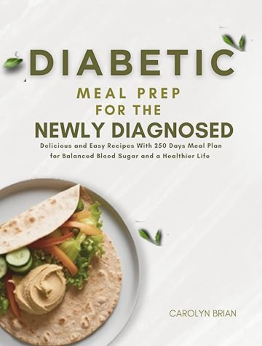
- Title: Diabetic Meal Prep For Beginners: The Best Way To Reverse Diabetes With Simple And Healthy Recipes a 28-Day Food Plan To Better Manage Your Issues And Return To Great Eating Habit
- Author: Melinda James
- Pages: 159
- Publisher (Publication Date): October 25, 2020
- Language: English
- ASIN: B08LXB8LYN
- Download File Format:EPUB
Are you looking for a complete guide on diabetic meal prep? Then keep reading…
With life always on the move, most of us often find it hard to make food daily. This often makes us opt out of the kitchen and dig ourselves by ready-to-cook or outside food that is highly processed and full of ingredients waiting to shoot up that blood sugar level you are so hard trying to control. Therefore, through this book, we have combined a list of recipes that can be made in advance and stored for later consumption.
This is called prepping the meal.
With the help of the detailed instructions, now you will be able to never fall back on the 28-day meal plan. The recipes selected are easy and can be your plus one even if you plan to visit friends or family at the end of the busy weekend. Prepping the meal helps you ditch that nearest drive-thru offering great takeaways full of carbs and sugar. Prepping also helps in saving costs one might incur when not shopped in bulk.
Every particular recipe mentioned in the book highlights the exact amount of food ingredients one needs to prepare the meal. Therefore, an easy calculation will suffice to calculate the food items you should purchase for prepping your meals.
Lastly, follow each instruction in the book very carefully and enjoy the meal aptly designed for the diabetic patient, anytime anywhere.
This book covers:
What is diabetes?
Type 1 and type 2 diabetes.
The causes of hyperglycemia and hypoglycemia.
Insulin
The miracle of alkaline ph
That food is your medicine.
Living the anti-diabetes lifestyle
28-day meal plan.
Diabetes recipes
And much more!
Diabetes belongs to the group of diseases known as metabolic. The diabetic patient, if not stabilized by treatment, has high blood sugar content. This is related to a hormone called insulin, produced by some very dedicated areas in the pancreas (islet cells).
The main, distinctive clinical signs of diabetes are the three “poly”, namely:
Polyuria: This corresponds to an excessive production of urine due to the inability of the kidneys to reabsorb water.
The polydipsia: A very intense thirst to compensate the loss of fluid in the kidneys.
The polyphagia: Excessive hunger or increased appetite, compensating for the loss of nutrients in the urine. In addition, sugar is unable to cross the cell membrane due to a lack of insulin; this is caused by different mechanisms in the cases of Type I or II
There are two main types of diabetes:
Type I Diabetes, also known as juvenile or insulin-dependent diabetes. This type of diabetes is due to insulin reduction or even the suppression of insulin production by pancreatic islets present in the pancreas. Due to the presence of sugar in the urine, it is so called Diabetes Mellitus, a term coined by Thomas Willis in 1675 when he noticed a sweet taste in the urine. “Mellitus” means “honey-sweet.” It mainly affects children and young adults.
Type II Diabetes, also known as non-insulin-dependent, insulin resistance or adult-onset diabetes. In this case, it is the cell membranes, (mainly muscle, liver, neural and fat cells), that resist the insulin action. The cell membranes become progressively impervious to sugar. The cell membrane sugar receptor is no longer able to cross the sugar molecules through the membrane to bring them into the cells.
![Diabetic Meal Prep 2020 by Adrian Belizeard [PDF: B086DGQ25N] Diabetic Meal Prep 2020 by Adrian Belizeard](https://cookebooks.info/wp-content/uploads/2020/03/B086DGQ25N.jpg)
![Diabetic Meal Prep for Beginners by AMZ Publishing [EPUB: B085XQTFLS] Diabetic Meal Prep for Beginners by AMZ Publishing](https://cookebooks.info/wp-content/uploads/2020/03/B085XQTFLS.jpg)
![Diabetic Cookbook by Alla Kay [PDF: 1673034039] Diabetic Cookbook by Alla Kay](https://cookebooks.info/wp-content/uploads/2020/09/1673034039.jpg)
![Smart Meal Prep for Beginners: Recipes and Weekly Plans for Healthy, Ready-to-Go Meals by Toby Amidor MS RD CDN [1641521252, Format: EPUB] 1641521252](https://cookebooks.info/wp-content/uploads/2018/07/1641521252.jpg)

![Diabetic Cookbook For Beginners by Margaret Willis [EPUB: B099QW65YB] Diabetic Cookbook For Beginners by Margaret Willis [EPUB: B099QW65YB]](https://cookebooks.info/wp-content/uploads/2022/05/B099QW65YB.jpg)